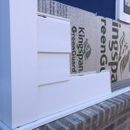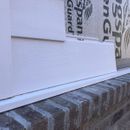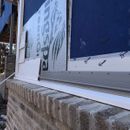Thickness of XPS Siding Underlayment
Hi GBA Community,
Zone 5, new construction. The siding team wants to use this XPS siding underlayment from Kingspan to furout the walls a little bit to install the siding. There is a watertable installed at the bottom where the first row of siding is not installing well because the starter strip is being installed over the watertable trim. (https://www.kingspan.com/us/en/products/rigid-insulation/fanfold-insulation/greenguard-q350/) This 3/8″ insulation is thick enough to bring the rest of the siding out a bit so there isn’t this “flaring out” that is currently happening.
From what I understand thinner foam can be considered be risky, because the R-value isn’t enough to keep my plywood sheathing dry during the winter. The greenguard is “Perforated to allow moisture vapor to escape”. Is this small amount of exterior insulation alright? Are there any risks?
Thanks,
Jay
GBA Detail Library
A collection of one thousand construction details organized by climate and house part












Replies
I don't see any references to vapor permeance on Kingspan's website, but you could email them to find out. I am not aware of specific rules for how permeable the wall's exterior layers need to be, but in climate zone 5, being heating-dominated, the more permeable the better, unless you have a reservoir cladding subject to solar vapor drive, such as brick, but not vinyl.
Your Siga Majvest WRB is 68 perms, which is just about the highest available. Industry standard product Typar is about 12 perms and Tyvek is 56 perms; I wouldn't want less than Typar's 12 perms, but it's somewhat subjective and depends on interior RH and what the wall assembly is. The more moisture that can get into the wall, the riskier it is to have vapor movement restricted on the exterior.
For climate zone 5 walls, for resistance to moisture accumulation ("condensation"), you need at least 27% of the wall's R-value to be on the exterior of the condensing surface, which in your case is the sheathing. You didn't mention what's in your walls but it's likely to be too much R-value for such a low exterior R-value. So the answer to your question really depends on the vapor permeance of the foam.
Hi Mike,
I just got off the phone with Kingspan. It's 1.3 perms.
My wall assembly is basic 2'x6' construction, taped plywood sheathing and either R-21 or R-23 insulation depending on what I end up going with.
I have just less than 70 perms if you combine the Siga & Kingspan.
Jay, will you have an interior vapor retarder? To calculate the perm rating of an assembly, you don't add them--they function more like screens or sieves, with the lowest-perm element having the tightest "holes."
In your case, even though you have a high-perm WRB, the foam layer will greatly slow outward drying. 1.3 perms is considered "vapor-semi-impermeable" so moisture will get through, but very slowly.
That said, there are roughly a bazillion homes with vinyl siding over that type of underlayment and few appear to have problems, so you might be fine. But moisture-related issues often take ten years or more to show up, and by then they have become major issues.
I recommend at least adding a variable-permeance interior membrane (Siga Majrex or similar), and even better would be to change from continuous foam on the exterior to foam strips or solid furring strips that allow the sheathing to dry readily to the exterior.
Thanks Mike for the suggestions. I do plan on having a vapor retarder, so that will also help.
Great suggestion about leveraging strips. Now that I think about it, I can either go with strips (foam or exposure 1 plywood - unless Pressure Treated is needed) or stop the fanfold all together once we hit the window because after the window there is no more furring out that needs to happen.
By the way, are you saying that if I left off the fanfold - I wouldn't need any vapor retarder because the sheathing will be able to easily dry to the outside due to the extremely high permanence of the Siga?
You're welcome. The latest IRC allows a class 3 vapor retarder (aka painted drywall) in your situation, as long as the siding is "vented:" https://codes.iccsafe.org/content/IRC2021P1/chapter-7-wall-covering#IRC2021P1_Pt03_Ch07_SecR702.7. Your building official could disagree, but vinyl siding is usually considered to have built-in ventilation since it's so open to air flow. So I don't think you need the interior membrane, but it is good insurance and there is next to no chance that it would do harm.
Furring strips can be pressure-treated or otherwise rot-resistant, but because they rarely see a lot of water and can dry readily, it's usually ok to use regular lumber.